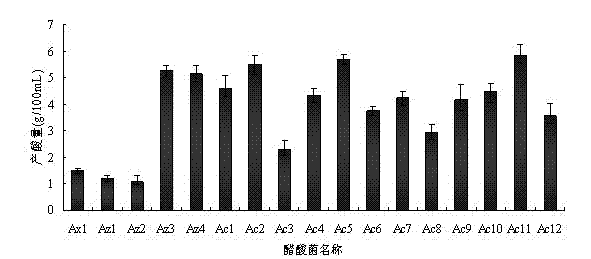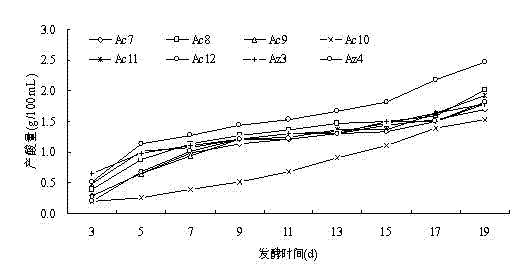Apricotskin-skin residue vinegar acetic bacterium as well as separating-purifying method and application method thereof
A kind of technology of apricot peel residue vinegar and acetic acid bacteria, applied in the direction of biochemical equipment and methods, separation of microorganisms, methods based on microorganisms, etc., can solve the problems of no fermentation performance, etc.
- Summary
- Abstract
- Description
- Claims
- Application Information
AI Technical Summary
Problems solved by technology
Method used
Image
Examples
Embodiment 1
[0053] The separation and purification of embodiment 1 acetic acid bacteria classification
[0054] (1) Selection of acetic acid bacteria isolation source:
[0055] Apricot peel residue: from Hualong Agriculture and Forestry Development Co., Ltd., Luntai County, Xinjiang;
[0056] Jujube vinegar: from Microbiology Laboratory, School of Food Science and Pharmacy, Xinjiang Agricultural University;
[0057] Vinegar grains: from Xinjiang Qiyi Sauce Garden Brewing Co., Ltd.
[0058] (2) Separation and purification of acetic acid bacteria:
[0059] 1) Enrichment culture of acetic acid bacteria:
[0060] Add 50g of apricot skin dregs to 250mL of water, culture at 30°C for 15 days to obtain apricot skin dregs natural fermentation broth, take 10g each of apricot skin dregs natural fermentation broth, jujube vinegar and vinegar grains, and put them into triangles containing 90ml of enriched medium In the bottle, cultivate at 30°C and 110r / min for 3 days to obtain the enriche...
Embodiment 2
[0067] Embodiment 2 Acetic acid bacteria Ac11 basic vinegar-making performance test
[0068] (1) Acid production test of acetic acid bacteria Ac11:
[0069] Add 100mL liquid medium (glucose 1%, yeast extract powder 1%, absolute ethanol 6% (v / v)) into a 500mL Erlenmeyer flask, insert the purified strain 5 rings, and culture at 30°C and 110r / min for 15d , to measure acid production.
[0070] After 15 days, take 2 mL of the above liquid culture solution, add 50 mL of distilled water, add 2-3 drops of 1% phenolphthalein reagent, and titrate with 0.1 mol / L standard NaOH solution until light pink. Calculate the acid content (as acetic acid) in the sample from the amount of NaOH solution consumed.
[0071] Acid production (g / L) = (V-V 0 ) × C NaOH ×60 / V 样
[0072] Where V: the amount of NaOH consumed in the titration of fermentation broth samples (ml);
[0073] V 0 : The amount of NaOH consumed in the blank medium control titration (ml);
[0074] C NaOH : concentration of...
Embodiment 3
[0084] Embodiment 3 Identification of acetic acid bacteria Ac11
[0085] (1) Physiological and biochemical identification:
[0086] Select contact enzyme test, glycerol ketogenic test, 5-ketogluconate formation test, gluconate test, ethanol oxidation test, fiber production according to the eighth edition of "Bergey's Bacterial Identification Manual" and "Common Bacterial System Identification Manual" The acetic acid bacteria Ac11 was tested by the element test, the water-soluble pigment test, the calcium acetate oxidation test, the starch hydrolysis test, and the calcium lactate oxidation test.
[0087] (2) Identification of acetic acid bacteria Ac11 16S rDNA:
[0088] Extraction of 16S rDNA:
[0089] Bacterial genomic DNA extraction kit (Beijing Zhuangmeng International Biogene Technology Co., Ltd.) was used to extract.
[0090] 16S rDNA PCR amplification:
[0091] Select bacterial universal primers for 16S rDNA amplification test:
[0092] Primer 1 sequence is 5'-...
PUM
| Property | Measurement | Unit |
|---|---|---|
| Acidity | aaaaa | aaaaa |
Abstract
Description
Claims
Application Information
 Login to View More
Login to View More - R&D
- Intellectual Property
- Life Sciences
- Materials
- Tech Scout
- Unparalleled Data Quality
- Higher Quality Content
- 60% Fewer Hallucinations
Browse by: Latest US Patents, China's latest patents, Technical Efficacy Thesaurus, Application Domain, Technology Topic, Popular Technical Reports.
© 2025 PatSnap. All rights reserved.Legal|Privacy policy|Modern Slavery Act Transparency Statement|Sitemap|About US| Contact US: help@patsnap.com



